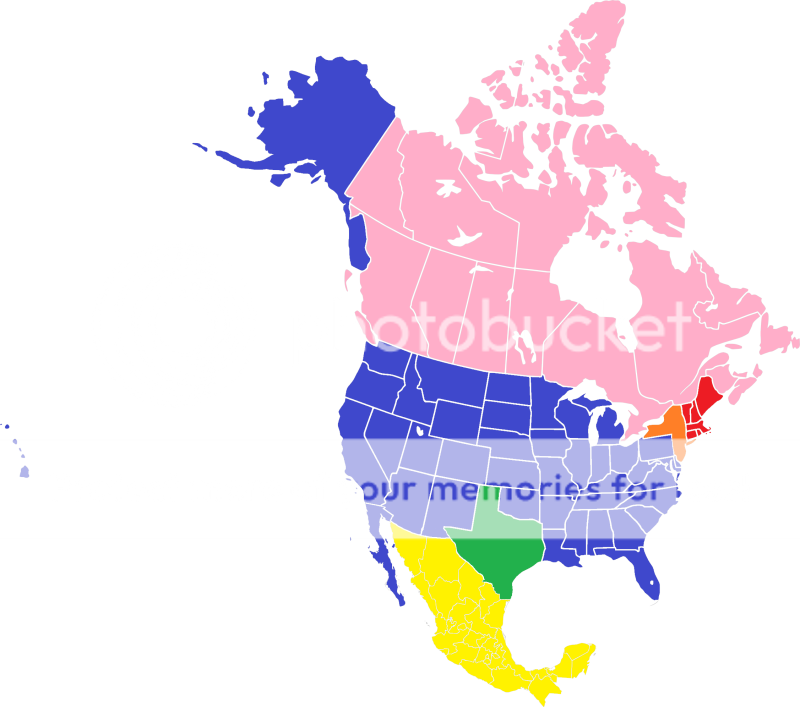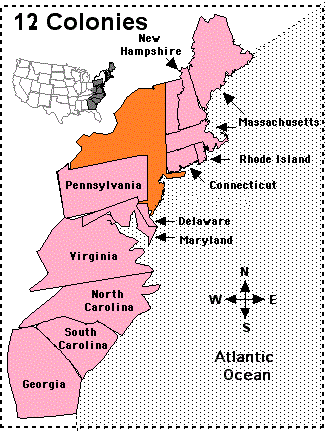Deleted member 2186
What if New Netherlands which remained part of the Dutch Republic due the English invasion fleet in 1664 was sunk in a storm before they could invade the Netherlands colony,wich resulted in this map and some other things I have so far created related to it.
I now that many borders look like OTl but this is my first real map I have ever made.

The nations are shown by color
Orange
Kingdom of New Netherlands
Official language(s): Netherlands (de facto) English and French regionally.
Capital: New Amsterdam
Largest city: New Amsterdam, 7,457,995
Government: Parliamentary democracy under a constitutional monarch.
Currency:Nieuw Nederlandse gulden
Current Population :17,639,307
Establishment: province status in 1624, Independence from the Batavian Republic in 1795, became a country within the United Kingdom of the Netherlands in 1815.
Green
Republic of Texas
Official language(s): English (de facto), Spanish and French regionally.
Capital: Houston
Largest city: Houston, 384,514
Government: Republic.
Currency:Texas Dollar
Current Population :6,714,824
Independence from Mexico: 1836 recognized in 1837 by the United States of America.
Red
Commonwealth of New England
Official language(s): English (de facto) with Netherlands and French regionally.
Capital:Boston
Largest city: Boston, 770,816
Government: Federal parliamentary democracy.
Currency:New England Dollar
Current Population :8,437,290
Independence from the United States of America: 1805 recognized in 1810.
Blue
The United States of America consist of 38 states and three territories.
United States of America
Official language(s): English (de facto)
Capital: Washington, DC.
Largest city: Chicago 3,396,808,
Government: Federal presidential constitutional republic.
Currency:United States Dollar
Current Population : 91,371,203
Independence from the Kingdom of Great Britain: 1776 recognized in 1785.
Yellow
United Mexican States
United Mexican States was formed in 1810 and has fought two wars whit the United States of America and several wars ranging from full scale to border wars with its main rival the Republic of Texas.
Official language(s): Spanish
Capital: Mexico City
Largest city: Mexico City
Government: Federal presidential constitutional republic.
Currency:Mexican peso
Current Population :18,000,000
Independence from Spain: 1810 recognized in 1821.
Pink
Canada
Official language(s): English and French
Capital: Ottawa
Largest city: Toronto
Currency: Canadian dollar
Current Population :11,382,000
Government: Federal parliamentary democracy and constitutional monarchy.
I now that many borders look like OTl but this is my first real map I have ever made.

The nations are shown by color
Orange
Kingdom of New Netherlands
Official language(s): Netherlands (de facto) English and French regionally.
Capital: New Amsterdam
Largest city: New Amsterdam, 7,457,995
Government: Parliamentary democracy under a constitutional monarch.
Currency:Nieuw Nederlandse gulden
Current Population :17,639,307
Establishment: province status in 1624, Independence from the Batavian Republic in 1795, became a country within the United Kingdom of the Netherlands in 1815.
Green
Republic of Texas
Official language(s): English (de facto), Spanish and French regionally.
Capital: Houston
Largest city: Houston, 384,514
Government: Republic.
Currency:Texas Dollar
Current Population :6,714,824
Independence from Mexico: 1836 recognized in 1837 by the United States of America.
Red
Commonwealth of New England
Official language(s): English (de facto) with Netherlands and French regionally.
Capital:Boston
Largest city: Boston, 770,816
Government: Federal parliamentary democracy.
Currency:New England Dollar
Current Population :8,437,290
Independence from the United States of America: 1805 recognized in 1810.
Blue
The United States of America consist of 38 states and three territories.
United States of America
Official language(s): English (de facto)
Capital: Washington, DC.
Largest city: Chicago 3,396,808,
Government: Federal presidential constitutional republic.
Currency:United States Dollar
Current Population : 91,371,203
Independence from the Kingdom of Great Britain: 1776 recognized in 1785.
Yellow
United Mexican States
United Mexican States was formed in 1810 and has fought two wars whit the United States of America and several wars ranging from full scale to border wars with its main rival the Republic of Texas.
Official language(s): Spanish
Capital: Mexico City
Largest city: Mexico City
Government: Federal presidential constitutional republic.
Currency:Mexican peso
Current Population :18,000,000
Independence from Spain: 1810 recognized in 1821.
Pink
Canada
Official language(s): English and French
Capital: Ottawa
Largest city: Toronto
Currency: Canadian dollar
Current Population :11,382,000
Government: Federal parliamentary democracy and constitutional monarchy.
Last edited by a moderator:
